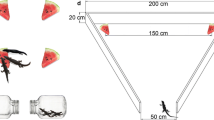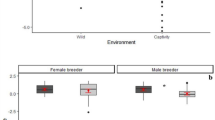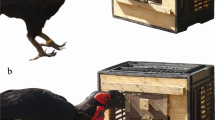Abstract
Social foraging is suggested to increase foraging efficiency, as individuals might benefit from public information acquired by monitoring the foraging activities of other group members. We conducted a series experiments with captive common marmosets (Callithrix jacchus) to investigate to what extent marmosets utilize social information about food location when foraging simultaneously with conspecifics. Subjects were confronted with dominant and subordinate demonstrators in three experiments which differed in the amount of information about food location available to the demonstrators. In all three experiments, the focal subjects’ performance in the social condition was not enhanced in comparison to a non-social control condition. Because we could rule out kleptoparasitism and aggressive displacements as explanations, we argue that the subjects’ tendency for scramble competition by avoiding others and dispersing over the foraging area seems to inhibit or mask the acquisition of social information about the location of rewarded patches.



Similar content being viewed by others
References
Barnard CJ, Sibly RM (1981) Producers and scroungers: a general model and its application to captive flocks of house sparrows. Anim Behav 29:543–550
Barton RA (1993) Sociospatial mechanisms of feeding competition in female olive baboons, Papio anubis. Anim Behav 46:791–802
Bautista LM, Alonso JC, Alonso JA (1998) Foraging site displacement in common crane flocks. Anim Behav 56:1237–1243
Beauchamp G, Kacelnik A (1991) Effects of the knowledge of partners on learning rates in zebra finches, Taeniopygia guttata. Anim Behav 41:247–253
Boccia ML, Laudenslager M, Reite M (1988) Food distribution, dominance, and aggressive behaviors in bonnet macaques. Am J Primatol 16:123–130
Bugnyar T, Huber L (1997) Push or pull: an experimental study on imitation in marmosets (Callithrix jacchus). Anim Behav 54:817–831
Bugnyar T, Kotrschal K (2002) Scrounging tactics in free-ranging ravens, Corvus corax. Ethology 108:993–1009
Cadieu JC, Cadieu N, Lauga J (1995) Local enhancement and seed choice in the juvenile canary, Serinus canarius. Anim Behav 50:793–800
Caldwell C, Whiten A (2004) Testing for social learning and imitation in common marmosets, Callithrix jacchus, using an artificial fruit. Anim Cogn 7:77–85
Caldwell C, Whiten A (2003) Scrounging facilitates social learning in common marmosets, Callithrix jacchus. Anim Behav 65:1085–1092
Clark CW, Mangel M (1984) Foraging and flocking strategies: information in an uncertain environment. Am Nat 123:626–641
Coolen I, Giraldeau L-A (2003) Incompatibility between antipredator vigilance and scrounger tactic in nutmeg mannikins, Lonchura pnctulata. Anim Behav 66:657–664
Coussi-Korbel S, Fragaszy DM (1995) On the relation between social dynamics and social learning. Anim Behav 50:1441–1453
Cresswell W (1997) Interference competition at low competitor densities in blackbirds, Turdus merula. J Anim Ecol 66:461–471
Dawson BR, Foss BM (1965) Observational learning in budgerigars. Anim Behav 13:470–474
Drea CM, Wallen K (1999) Low-status monkeys “play dumb” when learning in mixed social groups. Proc Natl Acad Sci USA 96(22):12965–12969
Dukas R, Kamil A (2000) The cost of limited attention in blue jays. Behav Ecol 11:502–506
Ens BJ, Cayford JT (1996) Feeding with other oystercatchers. In: Goss-Custard JD (ed) The oystercatcher: from individuals to populations. Oxford University Press, Oxford, pp 77–104
Fisher J, Hinde RA (1949) The opening of milk bottles by birds. Brit Birds 42:347–357
Forster FC (1995) Exploratory behavior and learning in laboratory marmosets (Callithrix jacchus jacchus): comparisons between experimental cage and home-range activity. Primates 36:501–514
Fragaszy D, Visalberghi E (1990) Social processes affecting the appearance of innovative behaviors in capuchin monkeys. Folia Primatol 54:155–165
Fragaszy D, Visalberghi E (2004) Socially biased learning in monkeys. Learn Behav 32:24–35
Galef BG (1996) Traditions in animals: field observations and laboratory analyses. In: Bekoff M, Jamieson D (eds) Readings in animal cognition. MIT Press, Cambridge, Massachusetts, pp 91–105
Galef BG, Giraldeau L-A (2001) Social influences on foraging in vertebrates: causal mechanisms and adaptive functions. Anim Behav 61:3–15
Giraldeau L-A (1997) The ecology of information use. In: Krebs JR, Davies NB (eds) Behavoiural ecology. Blackwell Science, Oxford, pp 42–68
Giraldeau L-A, Caraco T (2000) Social foraging theory. Princeton University Press, Princeton, New Jersey
Giraldeau L-A, Lefebvre, L (1987) Scrounging prevents cultural transmission of food-finding behaviour in pigeons. Anim Behav 35:387–394
Giraldeau L-A, Hogan JA, Clinchy MJ (1990) The payoffs to producing and scrounging: What happens when patches are divisable? Ethology 85:132–146
Goldizen AW (1987) Tamarins and marmosets: communal care of offspring. In: Smuts BB, Cheney DL, Seyfarth RM, Wrangham RW, Struhsaker TT (eds) Primate societies. The University of Chicago Press, Chicago, pp 34–43
Goss-Custard JD (1980) Competition for food and interference amongst waders. Ardea 68:31–52
Held S, Mendl M, Devereux C, Byrne RW (2000) Social tactics of pigs in a competitive foraging task: the 'informed forager' paradigm. Anim Behav 59:569–576
Heyes CM, Ray ED, Mitchell CR, Nokes T (2000) Stimulus enhancement: controls for social facilitation and local enhancement. Learn Motiv 31:83–98
Janson CH (1990) Ecological consequences of individual spatial choice in foraging groups of brown capchin monkeys, Cebus apella. Anim Behav 40:922–934
Krebs JR, MacRoberts M, Cullen J (1972) Flocking and feeding in the great tit (Parus major): an experimental study. Ibis 114:507–530
Laland KN, Williams K (1997) Shoaling generates social learning of foraging information in guppies. Anim Behav 53:1161–1169
Lefebvre L, Helder R (1997) Scrounger numbers and the inhibition of social learning in pigeons. Behav Process 40:201–207
Liker A, Barta Z (2002) The effects of dominance on social foraging tactic use in house sparrows. Behav 139:1061–1076
Mansour RA, Lipcius RN (1991) Density-dependent foraging and mutual interference in blue crabs. Mar Ecol Prog Ser 72:239–246
Mason JR, Reidinger RF (1981) Effects of social facilitation and observational learning on feeding behavior of the red-winged Blackbird (Agelaius phoeniceus). Auk 98:778–784
Menzel EW, Juno C (1985) Social foraging of marmoset monkeys and the question of intelligence. Phil Trans R Soc Lond Ser B 308:145–158
Mottley K, Giraldeau L-A (2000) Experimental evidence that group foragers can converge on predicted producer–scrounger equilibria. Anim Behav 60:341–350
Nicol CJ, Pope SJ (1999) The effects of demonstrator social status and prior foraging success on social learning in laying hens. Anim Behav 57:163–171
Ottoni EB (2000) EthoLog 2.2: a tool for the transcription and timing of behavior observation sessions. Behav Res Meth Instr 32:446–449
Passamani M, Rylands AB (2000) Feeding behaviour of Geoffroy's marmoset (Callithrix geoffroyi) in an Atlantic forest fragment of south-eastern brazil. Primates 41:27–38
Pitcher TJ, Magurran AE, Winfield IJ (1982) Fish in larger shoals find food faster. Behav Ecol Sociobiol 10:149–151
Powell GVN (1974) Experimental analysis of the social value of flocking by starlings Sturnus vulgaris in relation to predation and foraging. Anim Behav 22:501–505
Pulliam HR (1973) On the advantages of flocking. J Theor Biol 38:419–422
Robinson JG (1981) Spatial structure in foraging groups of wedge-capped capuchin monkeys Cebus nigrivittatus. Anim Behav 29:1036–1056
Ruxton GD (1993) Foraging in flocks—nonspatial models may neglect important costs. Ecol Modell 82:277–285
Rylands AB, de Faria DS (1993) Habitats, feeding ecology, and home range size in the genus Callithrix. In: Rylands AB (ed) Marmosets and tamarins. Systematics, behaviour, and ecology. Oxford University Press, Oxford, pp 262–269
Smith RD, Ruxton GD, Cresswell W (2001) Patch choice decisions of wild blackbirds: the role of preharvest public information. Anim Behav 61:1113–1124
Sokal RR, Rohlf FJ (1997) Biometry: the principles and practice of statistics in biological research. W.H. Freeman and Company, New York
Spence KW (1937) Experimental studies of learning and higher mental processes in infra-human primates. Psychol Bull 34:805–850
Stephens DW, Krebs JR (1986) Foraging theory. Princeton University Press, Princeton, New Jersey
Stevenson MF, Rylands AB (1988) The marmosets, genus Callithrix. In: Mittermeier RA, Rylands AB, Coimbra-Filho A, Fonseca GAB (eds) Ecology and behavior of neotropical primates, vol 2. World Wildlife Fund, Washington, DC, pp 131–222
Stillman RA, Goss-Custard JD, Alexander MJ (2000) Predator search pattern and the strength of interference through prey depression. Behav Ecol 11:597–605
Sutherland WJ (1983) Aggregation and the ideal free distribution. J Anim Ecol 65:813–824
Templeton JJ, Giraldeau L-A (1995) Patch assessment in foraging flocks of European starlings: evidence for the use of public information. Behav Ecol 6:65–72
Terborgh J (1983) Five new world primates: a study in comparative ecology. Princeton University Press, Princeton
Thompson WA, Vertinsky I, Krebs JR (1974) The survival value of flocking in birds: a simulation model. J Anim Ecol 43:785–803
Thorpe WH (1963) Learning and instinct in animals. Methuen, London
Valone TJ (1989) Group foraging, public information, and patch estimation. OIKOS 56:357–363
van Schaik CP (1989) The ecology of social relationships amongst female primates. In: Standen V, Foley R (eds) Comparative socioecology: the behavioral ecology of humans and other animals. Blackwell Scientific, Oxford, pp 195–218
Voelkl B, Huber L (2000) True imitation in marmosets. Anim Behav 60:195–202
Warden CJ, Fjeld HA, Koch AM (1940) Imitative behavior in cebus and rhesus monkeys. J Genet Psychol 56:311–322
Zentall TR (2004) Action imitation in birds. Learn Behav 32:15–23
Acknowledgements
This research was supported by a grant from the Austrian Academy of Science (DOC 21052) to Bernhard Voelkl. We thank the Konrad Lorenz Institute for Evolution and Cognition Research, Altenberg for hospitality and Thomas Bugnyar, Claudia Kasper, the editor and three anonymous reviewers for valuable comments on the manuscript. EthoLog is a freeware computer program for real-time continuous recording of behavioural data provided by E. B. Ottoni, available at http://www.geocites.com/ebottoni/ethohome.html. The experiments comply with the Austrian laws regulating animal husbandry and animal experiments.
Author information
Authors and Affiliations
Corresponding author
Rights and permissions
About this article
Cite this article
Voelkl, B., Huber, L. Common marmosets (Callithrix jacchus) do not utilize social information in three simultaneous social foraging tasks. Anim Cogn 10, 149–158 (2007). https://doi.org/10.1007/s10071-006-0053-4
Received:
Revised:
Accepted:
Published:
Issue Date:
DOI: https://doi.org/10.1007/s10071-006-0053-4




